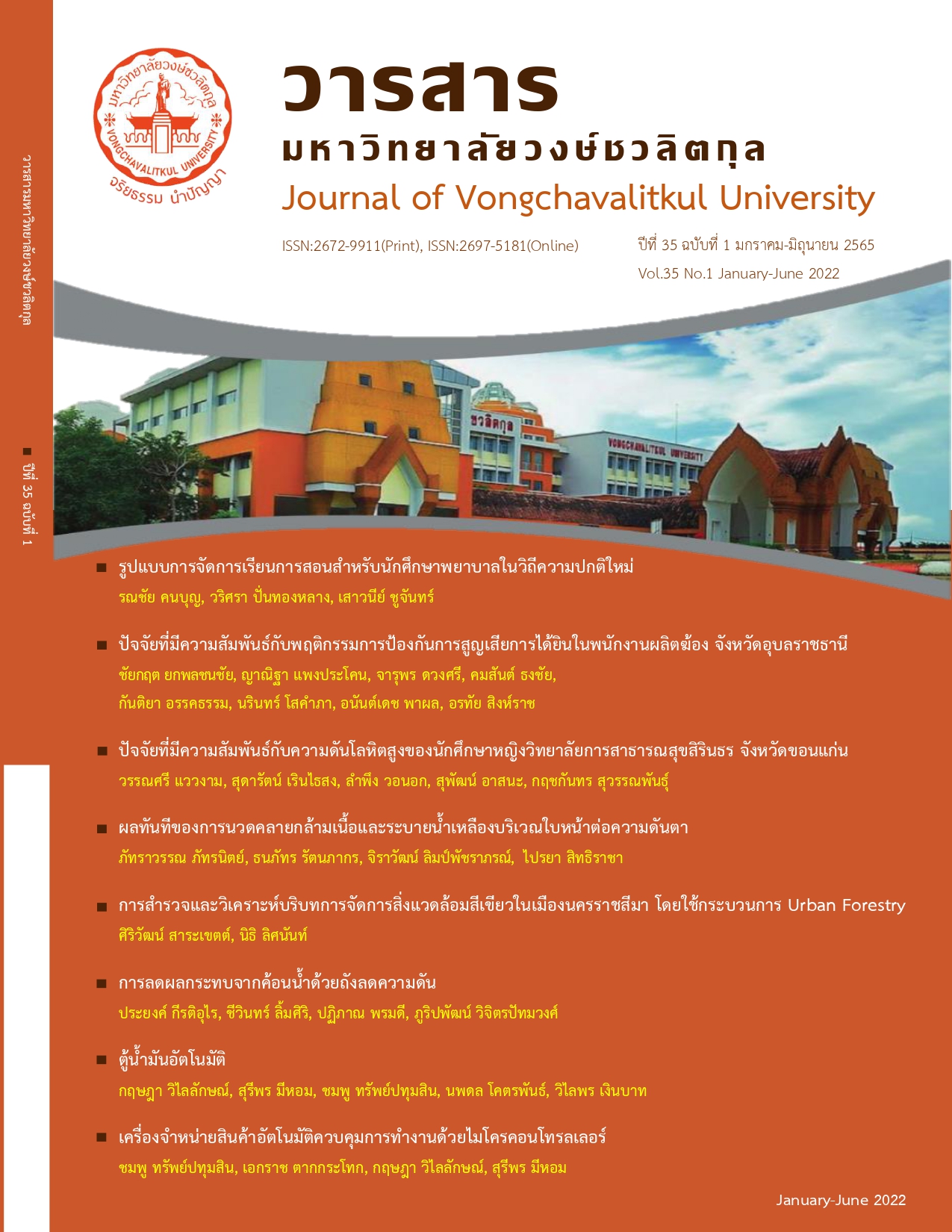ผลทันทีของการนวดคลายกล้ามเนื้อและระบายน้ำเหลืองบริเวณใบหน้าต่อความดันตา
คำสำคัญ:
ความดันตาสูง, นวดระบายน้ำเหลือง, นวดคลายกล้ามเนื้อบทคัดย่อ
บทคัดย่อ
วัตถุประสงค์: ความดันตาสูงเป็นปัจจัยหลักที่ทำให้เกิดโรคต้อหินและเกิดการสูญเสียการมองเห็นในที่สุด ดังนั้น การรักษาโดยการลดความดันตาจึงเป็นการรักษาหลัก ร่วมกับเทคนิคอื่น เช่น นวดการระบายน้ำเหลือง การคลายกล้ามเนื้อ เพื่อเพิ่มการไหลออกของน้ำเหลืองรอบใบหน้าและศีรษะ ซึ่งในการศึกษาที่ผ่านมาพบว่ามีความเป็นไปได้ที่จะอาศัยหลักการลดการติดขัดจากการเกร็งตัวของกล้ามเนื้อ ระบายน้ำเหลืองบริเวณใบหน้า จะเพิ่มการไหลออกของน้ำเลี้ยงลูกตาลงสู่ระบบหลอดเลือดและน้ำเหลือง ส่งผลทำให้ความดันตาลดลง การวิจัยนี้จึงมีวัตถุประสงค์เพื่อศึกษาผลของการนวดคลายกล้ามเนื้อและระบายน้ำเหลืองบริเวณใบหน้าต่อความดันตา
วิธีการวิจัย: โดยศึกษาในอาสาสมัครสุขภาพดีที่มีการทำงานหน้าจอคอมพิวเตอร์ระหว่างวันมากกว่า 4 ชั่วโมงต่อวัน (อายุเฉลี่ย 37.18+11.58 ปี) จำนวน 22 คน โดยอาสาสมัครจะได้รับการนวดคลายกล้ามเนื้อและระบายน้ำเหลืองบริเวณใบหน้า 15 นาที
ผลการวิจัย: จากผลการศึกษาพบว่าเมื่อเปรียบเทียบความดันลูกตาก่อนและหลังการนวดคลายกล้ามเนื้อและระบายน้ำเหลืองบริเวณใบหน้า ความดันตาลงลง โดยความดันตาขวาเฉลี่ยลดลงอย่างมีนัยสำคัญทางสถิติ 0.87+1.43 มิลลิเมตรปรอท (p=0.01) ค่าความดันตาซ้ายเมื่อเปรียบเทียบก่อนและหลังได้รับการนวดคลายกล้ามเนื้อและระบายน้ำเหลืองบริเวณใบหน้าเฉลี่ยลดลง 0.63+1.74 (p=0.105) อย่างไม่มีนัยสำคัญทางสถิติ
สรุป การนวดคลายกล้ามเนื้อและระบายน้ำเหลืองบริเวณใบหน้ามีความเป็นไปได้ที่จะสามารถลดความดันตาในอาสาสมัครสุขภาพดีที่มีการทำงานหน้าจอคอมพิวเตอร์ระหว่างวันมากกว่า 4 ชั่วโมงต่อวัน
References
คุณาวุฒิ วรรณจักร, ยอดชาย บุญประกอบ, รัตนวดี ณ นคร, วิชัย อึงพินิจพงศ์. (2553). ผลทันทีของการนวดแผนไทยต่อการเปลี่ยนแปลงอุณหภูมิและการเคลื่อนไหวของมือในผู้ป่วยโรคหนังแข็ง: การศึกษานำร่อง. วารสารเทคนิคการแพทย์และกายภาพบำบัด, 22(1), 92-102. https://he01.tci-thaijo.org/index.php/ams/article/view/66219/54169
วณิชา ชื่นกรองแก้ว และ พิพัฒน์ เชี่ยววิทย์. (2546). ตำราประสาทจักษุวิทยา. มหาวิทยาลัยมหิดล. คณะแพทยศาสตร์ศิริราชพยาบาล. สถานเทคโนโลยีการศึกษาแพทยศาสตร์. งานตำราวารสารและสิ่งพิมพ์
สิรินาฏ เมธาธราธิป, วิชัย อึงพินิจพงศ์, อุไรวรรณ ชัชวาลย์. (2553). การศึกษานำร่องผลทันทีของการนวดหน้าแบบประยุกต์ต่อการเปลี่ยนแปลงการไหลเวียนโลหิต อุณหภูมิ และความยืดหยุ่นของผิวหนังบรเวณใบหน้า. วารสารเทคนิคการแพทย์และกายภาพบำบัด, 22(1), 63-70. https://he01.tcithaijo.org/index. php/ams/article/view/66216/54166
Bengtsson, B., & Heijl, A. (2005). Diurnal IOP fluctuation: not an independent risk factor for glaucomatous visual field loss in high-risk ocular hypertension. Graefe’s Archive for Clinical and Experimental Ophthalmology, 243(6), 513–8. https://doi.org/10.1007/s00417-004-1103-8
Bergeå, B., Bodin, L., & Svedbergh, B. (1999). Impact of intraocular pressure regulation on visual fields in open-angle glaucoma. Ophthalmology, 106(5), 997–1004. https://doi.org/10.1016/S0161-6420(99)00523-0
García-Resúa, C., Pena-Verdeal, H., Miñones, M., Giraldez, M. J., & Yebra-Pimentel, E. (2013). Reliability of the non-contact tono-pachymeter Tonopachy NT-530P in healthy eyes. Clinical and Experimental Optometry, 96, 286- 294. https://doi.org/10.1111/j.1444-0938.2012.00818.x
Goel, M., Picciani, R. G., Lee, R. K., & Bhattacharya, S. K. (2010). Aqueous humor dynamics: A review. The Open Ophthalmology Journal, 4, 52-9. https://doi.org/10.2174/1874364101004010052
Jasien, J. V., Jonas, J. B., de Moraes, C. G., & Ritch, R. (2015). Intraocular pressure rise in subjects with and without glaucoma during four common yoga positions. PLoS ONE, 10(12). https://doi.org/10.1371/journal.pone.
Jurch, S. E. (2009). Clinical massage therapy: Assessment and treatment of orthopedic conditions. New York: McGraw-Hill.
Kass, M. A., Heuer, D. K., Higginbotham, E. J., Johnson, C. A., Keltner, J. L.,
Miller, J. P., Parrish, R. K., Wilson, M. R., & Gordon, M. O. (2002). The Ocular Hypertension Treatment Study: A randomized trial determines that topical ocular hypotensive medication delays or prevents the onset of primary open-angle glaucoma. Archives of Ophthalmology, 120(6), 701–713; discussion 829-830. https://doi.org/10.1001/archopht.120.6.701
Kitazawa, Y., & Horie, T. (1975). Diurnal variation of intraocular pressure in
primary open-angle glaucoma. American Journal of Ophthalmology, 79(4), 557–66. https://doi.org/10.1016/0002-9394(75)90792-8
Lam, A. K. C., & Chen, D. (2007). Effect of ocular massage on intraocular
pressure and corneal biomechanics. Eye, 21(9), 1245-1246.
https://doi.org/10.1038/sj.eye.6702928; published online 6 July 2007
League, J. E. E., Rivera, J. A., & Leuenberger, E. U. (2008). The effect of body massage lying face down on intraocular pressure in normal eyes. Philippine Journal of Ophthalmology, 33(1), 27-29.
Leske, M. C., Heijl, A., Hussein, M., Bengtsson, B., Hyman, L., & Komaroff, E. (2003). Factors for glaucoma progression and the effect of treatment: The early manifest glaucoma trial. Archives of Ophthalmology, 121(1), 48–56.
https://doi.org/10.1001/archopht.121.1.48
Malihi, M., & Sit, A. J. (2012). Effect of head and body position on intraocular pressure. Ophthalmology, 119(5), 987-91. https://doi.org/10.1016/j.ophtha.2011.11.024
Mittal, S. K., Mittal, S., Verma, P., Deepak, D., Jain, N., & Garg, N. (2014). A study showing influence of autonomic nervous activity and meditation on intra-ocular pressure. Neuro-Ophthalmology & Visual Neuroscience, 1(1), 1-7.
https://doi.org/10.12691/novn-1-1-1
Moyer, C. A., Rounds, J., & Hannum, J. W. (2004). Meta-analysis of massage therapy research. Psychological Bulletin, 130(1), 3-18. https://doi.org/10.1037/0033-2909.130.1.3
Pandey, R., Samuel, A. J., Aranha, V. P., Pandey, A., & Narkeesh, K. (2017).
Non-pharmacological therapies for primary open angle glaucoma: A quasi-experimental pilot study. Saudi Journal of Ophthalmology, 31(2), 95–8. https://doi.org/10. 1016/ j.sjopt.2017.03.001
Quigley, H. A., & Addicks, E. M. (1980). Chronic experimental glaucoma in primates. II. Effect of extended intraocular pressure elevation on optic nerve head and axonal transport. Investigative Ophthalmology & Visual Science, 19(2), 137–152.
Quigley, H. A., & Broman, A. T. (2006). The number of people with glaucoma worldwide in 2010 and 2020. The British Journal of Ophthalmology, 90(3), 262–7. https://doi.org/10.1136/bjo.2005.081224
Richter, H. O., Bänziger, T., Abdi, S., & Forsman, M. (2010). Stabilization of
gaze: A relationship between ciliary muscle contraction and trapezius muscle activity. Vision Research, 50(23), 2559-2569. https://doi.org/10.1016/j.visres.2010.08.021
Ruderman, J. M., Jampol, L. M., & Krueger, D. M. (1988). Visual loss caused by subretinal hemorrhage and rupture of Bruch’s membrane after digital ocular massage. American Journal of Ophthalmology, 106(4), 493–494. https://doi.org/10.1016/0002-9394(88)90894-x
Saboo, U. S., Amparo, F., Shikari, H., & Dana, R. (2016). Prevalence of
ocular hypertension and glaucoma in patients with chronic ocular graft-versus-host disease. Graefe’s Archive for Clinical and Experimental ophthalmology, 254(5), 923–928. https://doi.org/ 10.1007/s00417-016-3312-3.
Shahidullah, M., Al-Malki, W. H., & Delamere, N. A. (2011). Mechanism
of aqueous humor secretion, its regulation and relevance to glaucoma. In Glaucoma-Basic and Clinical Concepts. IntechOpen. https://doi.org/10.5772/26559
Smith, M., Geffen, N., Alasbali, T., Buys, Y. M., & Trope, G. E. (2010). Digital
ocular massage for hypertensive phase after Ahmed valve surgery. Journal of Glaucoma, 19(1), 11-4. https://doi.org/10.1097/IJG.0b013e 31819c485b
Teng, C., Gurses-Ozden, R., Liebmann, J. M., Tello, C., & Ritch, R. (2003).
Effect of a tight necktie on intraocular pressure. The British Journal of Ophthalmology, 87(8), 946–8. https://doi.org/10.1136/bjo.87.8.946
Downloads
เผยแพร่แล้ว
How to Cite
ฉบับ
บท
License
Copyright (c) 2022 Pattrawan Pattaranit, asst.prof.,MD, Jirawat Limphatcharaporn , Dr.

This work is licensed under a Creative Commons Attribution-NonCommercial-NoDerivatives 4.0 International License.





